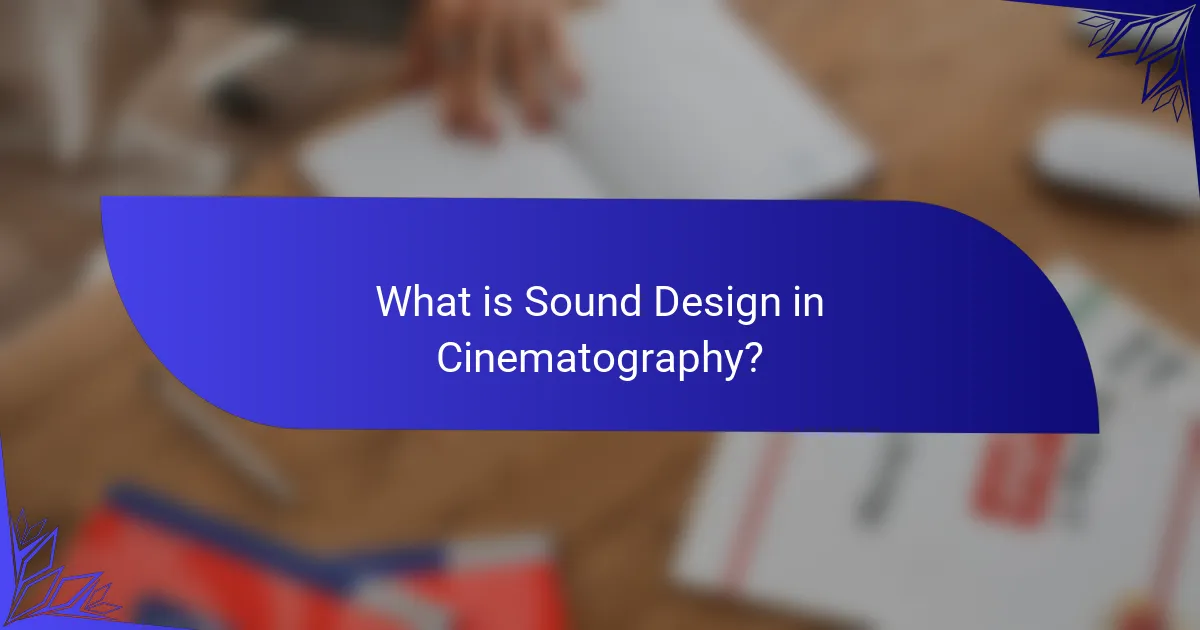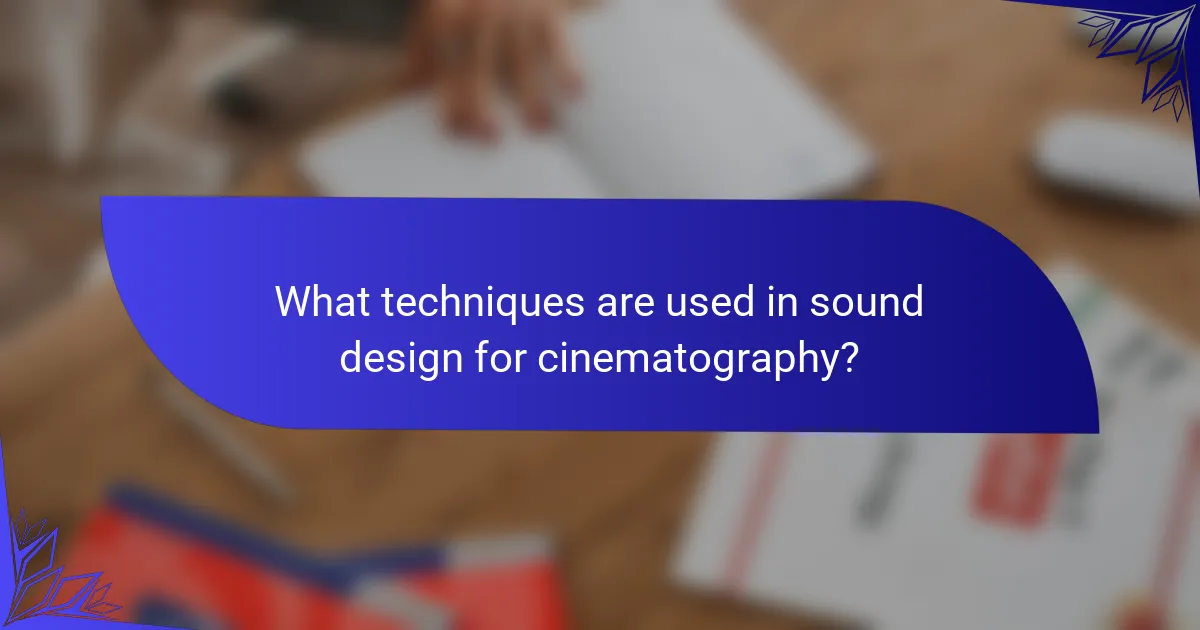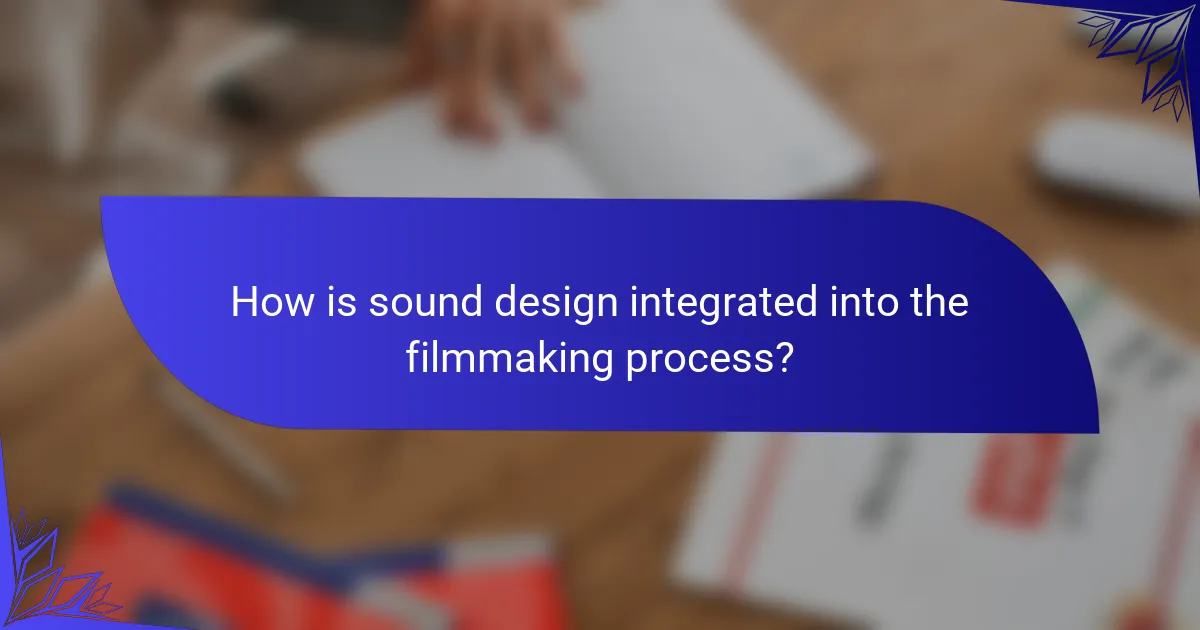Sound design in cinematography is the process of creating and manipulating audio elements to enhance film storytelling. It involves techniques such as sound editing, mixing, and Foley artistry, which work together to establish mood and atmosphere while complementing visual elements. Sound designers collaborate with directors throughout the filmmaking process, from pre-production to post-production, ensuring that audio elements are effectively integrated to evoke emotions and engage audiences. The article will explore the various tools and techniques used in sound design, highlighting its critical role in shaping the cinematic experience.

What is Sound Design in Cinematography?
Sound design in cinematography refers to the creation and manipulation of audio elements to enhance the storytelling of a film. It involves the use of dialogue, sound effects, and music to create an immersive experience. Sound designers work closely with directors and cinematographers to align audio with visual elements. They utilize various tools and techniques to achieve desired effects. This includes recording, editing, and mixing sounds. The goal is to evoke emotions and complement the narrative. Effective sound design can significantly impact audience engagement and perception. It plays a crucial role in establishing mood and atmosphere within a film.
How does sound design influence cinematic storytelling?
Sound design significantly influences cinematic storytelling by enhancing emotional depth and narrative engagement. It creates an immersive experience that guides audience perception. Through the use of sound effects, dialogue, and music, filmmakers convey mood and atmosphere. For instance, a suspenseful score can heighten tension during critical scenes. Sound design also establishes character identities and relationships through distinct auditory cues. According to a study by the University of Southern California, sound can evoke specific emotional responses, reinforcing the visual narrative. This interplay between sound and visuals shapes viewer interpretation, making storytelling more impactful.
What are the key elements of sound design in film?
The key elements of sound design in film include dialogue, sound effects, and music. Dialogue is crucial for storytelling and character development. It conveys emotions and plot points. Sound effects enhance realism and create atmosphere. They can range from ambient sounds to specific actions. Music sets the tone and evokes emotions. It influences audience perception and engagement. These elements work together to create a cohesive auditory experience. Effective sound design can significantly impact a film’s overall quality and viewer immersion.
How does sound design enhance viewer engagement?
Sound design enhances viewer engagement by creating an immersive audio experience. It captures the audience’s attention through sound effects, music, and dialogue. Effective sound design evokes emotions and sets the mood for scenes. Research shows that well-crafted audio can increase viewer retention by up to 50%. Sound cues guide emotional responses, making scenes more impactful. The synchronization of sound with visuals creates a cohesive storytelling experience. This integration keeps viewers invested in the narrative. Overall, sound design is crucial for enhancing the overall cinematic experience.
Why is sound design important in the filmmaking process?
Sound design is crucial in filmmaking because it enhances storytelling and emotional engagement. It creates an immersive experience for the audience. Effective sound design can evoke specific emotions and set the tone of a scene. Research shows that sound impacts viewer perception significantly. For example, a study by the University of Southern California found that sound can influence how audiences interpret visual narratives. Additionally, sound design helps to establish realism in films. It can highlight actions, indicate changes in mood, and provide context. Overall, sound design is an integral component that supports the visual elements of filmmaking.
What role does sound design play in audience perception?
Sound design significantly influences audience perception in film and media. It shapes the emotional response of viewers. Effective sound design enhances storytelling by creating atmosphere and mood. Specific sound elements, such as music and sound effects, guide audience reactions. Research shows that sound can evoke specific emotions, altering how scenes are interpreted. For instance, a study by the University of Southern California found that soundtracks can change the perceived intensity of a scene. This demonstrates the power of audio in shaping viewer experience. Overall, sound design is essential for engaging audiences and enhancing narrative depth.
How can sound design affect the emotional tone of a film?
Sound design significantly influences the emotional tone of a film. It shapes audience perception and enhances storytelling. For example, high-pitched sounds can evoke tension and anxiety. Conversely, soft, melodic sounds often create a sense of calm or nostalgia. The use of silence can amplify dramatic moments, intensifying emotional responses. Research indicates that soundtracks can alter viewers’ emotional reactions by up to 50%. Effective sound design aligns with visual elements to reinforce themes and character emotions. This synergy enhances immersion and engagement, making the film’s emotional tone more impactful.

What techniques are used in sound design for cinematography?
Sound design for cinematography employs various techniques to enhance the auditory experience. These techniques include sound editing, sound mixing, and Foley artistry. Sound editing involves selecting and arranging sound elements to match the visuals. Sound mixing balances different audio tracks, ensuring clarity and cohesion. Foley artistry creates everyday sound effects that sync with the film’s action. Additionally, ambient sound design establishes the environment’s atmosphere. Dialogue editing ensures clear and intelligible speech. Layering sounds adds depth and richness to the audio landscape. Each technique contributes to storytelling and emotional impact in film.
How do sound designers create and manipulate sound effects?
Sound designers create and manipulate sound effects using various techniques and tools. They record sounds in real environments or use synthesized sounds to generate unique audio elements. Sound designers often apply digital audio workstations (DAWs) for editing and layering sounds. They utilize plugins and effects such as reverb, delay, and equalization to enhance audio quality. Foley artists recreate everyday sounds to match on-screen actions, adding realism. Sound libraries provide a vast range of pre-recorded effects for quick access. Designers may also manipulate pitch, speed, and volume to fit specific scenes. The combination of these methods results in immersive soundscapes that support the visual narrative.
What are the different methods for recording sound on set?
The different methods for recording sound on set include using boom microphones, lavalier microphones, and shotgun microphones. Boom microphones are mounted on a long pole to capture sound from a distance. They are effective for capturing dialogue without being in the frame. Lavalier microphones are small, clip-on mics that can be attached to actors. They provide clear audio while allowing freedom of movement. Shotgun microphones are highly directional and are used to capture sound from a specific source. They are ideal for isolating dialogue in noisy environments. Each method has its own advantages based on the filming conditions and desired sound quality.
How do post-production techniques enhance sound design?
Post-production techniques enhance sound design by refining audio elements for clarity and impact. These techniques include editing, mixing, and sound effects creation. Editing allows for precise alignment of sound with visuals. Mixing balances audio levels, ensuring dialogue, music, and effects complement each other. Sound effects creation adds depth and realism to scenes. Techniques like equalization and compression improve sound quality. Additionally, reverb and delay can create a sense of space. These enhancements lead to a more immersive viewer experience. Studies show that well-executed sound design significantly affects audience engagement and emotional response.
What are the essential tools for sound design in cinematography?
The essential tools for sound design in cinematography include digital audio workstations (DAWs), microphones, and audio interfaces. DAWs like Pro Tools and Adobe Audition allow for detailed audio editing and mixing. Microphones such as shotgun mics and lavalier mics capture high-quality sound. Audio interfaces connect microphones to computers, ensuring optimal sound quality. Additionally, field recorders enable sound capture in various environments. Sound libraries provide a range of effects and ambient sounds. Each tool plays a critical role in creating immersive audio experiences in film.
What software is commonly used for sound editing?
Commonly used software for sound editing includes Pro Tools, Adobe Audition, and Audacity. Pro Tools is an industry standard in professional studios. It offers advanced features for mixing and editing audio. Adobe Audition is popular for its user-friendly interface and powerful tools. Audacity is a free, open-source option favored by beginners. These software programs are widely recognized for their capabilities in sound design and editing.
Which hardware is essential for sound design professionals?
Essential hardware for sound design professionals includes digital audio workstations (DAWs), audio interfaces, and studio monitors. DAWs, such as Pro Tools or Ableton Live, are crucial for editing and mixing audio. Audio interfaces convert analog signals to digital, ensuring high-quality sound capture. Studio monitors provide accurate sound reproduction for mixing. Additionally, microphones and headphones are vital for recording and monitoring. Professional-grade microphones capture sound with precision. High-quality headphones allow for detailed listening during editing. This combination of hardware forms the foundation for effective sound design in various media.

How is sound design integrated into the filmmaking process?
Sound design is integrated into the filmmaking process through various stages, enhancing the narrative and emotional impact. It begins in pre-production, where sound designers collaborate with directors to establish the auditory vision. During production, sound is captured on set, including dialogue and ambient sounds. In post-production, sound designers create and edit sound effects, Foley, and music to complement the visuals. This process involves mixing and mastering to ensure audio clarity and balance. Studies show that effective sound design can significantly influence audience perception and engagement. For instance, a well-designed soundscape can evoke specific emotions, enhancing the overall cinematic experience.
What are the stages of integrating sound design in a film?
The stages of integrating sound design in a film include pre-production, production, and post-production. During pre-production, sound design concepts are developed alongside the script. This stage involves planning sound effects, dialogue, and music. In production, sound is recorded on set. This includes capturing dialogue and ambient sounds. The quality of sound recorded directly impacts the final output. Post-production is where sound design truly comes to life. Sound editors and designers work to create and enhance audio elements. They mix dialogue, sound effects, and music to achieve the desired emotional impact. Each stage is crucial for achieving a cohesive and immersive auditory experience in the film.
How does collaboration between sound designers and directors occur?
Collaboration between sound designers and directors occurs through clear communication and shared vision. Sound designers interpret the director’s concept and enhance it with audio elements. They participate in pre-production meetings to align on creative goals. During production, they often work on set to capture sound effectively. Post-production involves sound designers creating soundscapes that match the director’s vision. Feedback loops are established for adjustments and refinements. This iterative process ensures that the final audio complements the visual storytelling. Successful collaborations lead to immersive cinematic experiences.
What is the process of syncing sound with visuals?
The process of syncing sound with visuals involves aligning audio tracks with corresponding video frames. This process begins in post-production after filming is completed. Editors use software to visualize both audio waveforms and video timelines. They identify key moments in the video, such as dialogue or sound effects. The audio is then adjusted to match these visual cues precisely. This alignment ensures that sounds occur at the correct moments. Proper syncing enhances the viewer’s experience and maintains narrative coherence. Accurate syncing is crucial in film and television production. It can significantly impact audience engagement and emotional response.
What challenges do sound designers face in cinematography?
Sound designers face several challenges in cinematography. One significant challenge is capturing high-quality audio in complex environments. Background noise can interfere with dialogue and sound effects. Additionally, syncing audio with visuals can be difficult, especially in fast-paced scenes. The need for creative soundscapes can also pressure sound designers to innovate constantly. Budget constraints may limit access to advanced equipment or skilled personnel. Furthermore, collaboration with directors and other departments can lead to conflicting creative visions. These factors can complicate the sound design process and impact the final product’s quality.
How can environmental noise impact sound design?
Environmental noise can significantly impact sound design by altering the clarity and effectiveness of audio elements. It introduces unwanted sounds that can mask intended audio cues. This interference can detract from the viewer’s experience and emotional engagement. For instance, background noise can make dialogue harder to understand. It may also force sound designers to use noise reduction techniques, which can compromise audio quality. Additionally, environmental noise can influence the choice of sound recording locations. The presence of ambient sounds may necessitate adjustments in sound mixing. Overall, managing environmental noise is crucial for achieving high-quality sound design in cinematography.
What solutions exist for overcoming sound design obstacles?
Solutions for overcoming sound design obstacles include using advanced software tools, collaborating with sound professionals, and investing in quality equipment. Advanced software tools, such as Pro Tools and Adobe Audition, provide features for precise editing and mixing. Collaboration with experienced sound designers can lead to innovative solutions and improved sound quality. Investing in quality microphones and audio interfaces enhances the overall sound capture. Additionally, utilizing sound libraries can provide a diverse range of sound effects. Regular practice and education in sound design techniques can also help overcome common challenges. Each of these solutions addresses specific obstacles faced in sound design.
What best practices should sound designers follow in cinematography?
Sound designers should prioritize collaboration with directors and cinematographers. Effective communication ensures alignment on the film’s vision. They must also understand the narrative to enhance storytelling through sound. Utilizing location sound recording is crucial for authenticity. This practice captures ambient sounds that enrich the film’s atmosphere. Additionally, sound designers should employ sound libraries judiciously. Selecting high-quality sounds enhances the overall audio experience. Finally, continuous testing of sound mixes in different environments is essential. This ensures the sound translates well across various playback systems.
How can sound designers ensure high-quality audio in films?
Sound designers can ensure high-quality audio in films by using professional recording equipment. High-quality microphones capture clear sound during filming. They also utilize sound editing software for precise audio manipulation. Mixing techniques enhance the overall sound experience. Properly balancing dialogue, music, and sound effects is essential. Sound designers often conduct thorough sound checks before recording. They collaborate closely with directors to align audio with the film’s vision. Continuous learning about new technologies and techniques also contributes to audio quality.
What tips can improve collaboration with other filmmaking departments?
Establishing clear communication is essential for improving collaboration with other filmmaking departments. Regular meetings ensure everyone is aligned on project goals and timelines. Creating shared documents allows for real-time updates and feedback. Utilizing collaborative tools, like project management software, enhances coordination. Encouraging open dialogue fosters a supportive environment for creative ideas. Defining roles and responsibilities clarifies expectations among departments. Respecting each department’s expertise promotes mutual trust and collaboration. Building relationships through team-building activities strengthens interdepartmental connections.
Sound design in cinematography is the process of creating and manipulating audio elements to enhance film storytelling. This article provides an overview of sound design techniques, tools, and integration into the filmmaking process. Key elements include dialogue, sound effects, and music, which work together to create an immersive experience and evoke emotions. The article also addresses the challenges sound designers face, best practices for ensuring high-quality audio, and the importance of collaboration with other filmmaking departments. Additionally, it highlights the impact of sound design on audience perception and engagement.